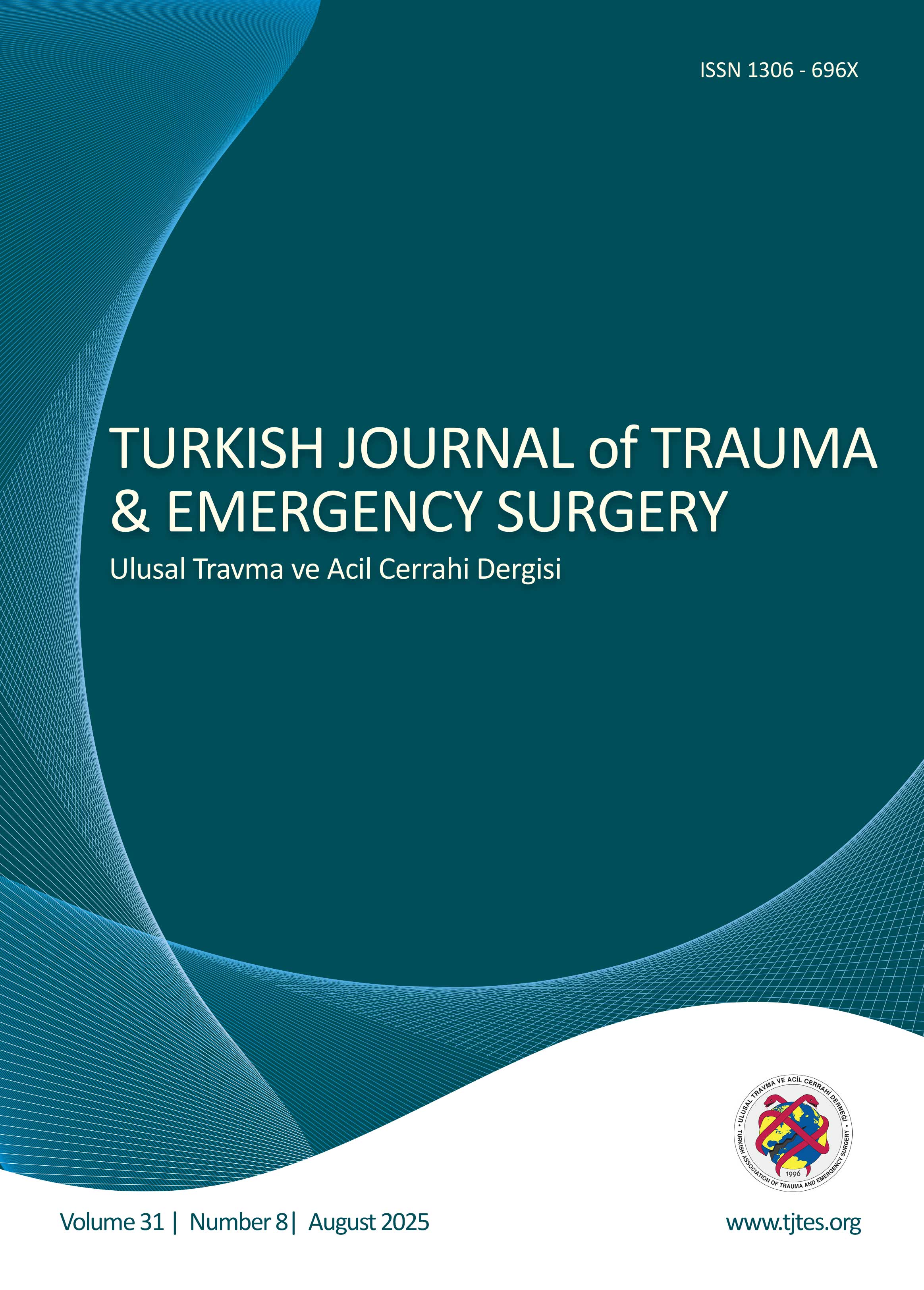Hızlı Arama
BT'de apendikolit saptanan/saptanmayan akut apandisitlerde BT apandisit skoru ve laboratuvar parametrelerinin değerlendirilmesi
Tuğberk Baştürk1, Mehmet Duran2, Seda Baştürk31Uşak Üniversitesi Tıp Fakültesi, Radyoloji Ana Bilim Dalı, Uşak2Adıyaman Eğitim Ve Araştırma Hastanesi, Radyoloji Kliniği, Adıyaman
3Uşak Eğitim Ve Araştırma Hastanesi, Cerrahi Onkoloji Servisi, Uşak
AMAÇ: Akut apandisitin (AA) ameliyatsız tedavisine olan artmış ilgi, apendikoliti daha önemli bir konu haline getirmiştir. Bu çalışmada, AA tanısı alan, bilgisayarlı tomografide (BT) apendikoliti olan ve olmayan hastalarda BT apandisit skorunu (BTAS), tam kan sayımını (CBC), C-reaktif protein (CRP) değerlerini ve sistemik immün inflamasyon indeksini (SII) değerlendirmek, perfore olan ve olmayan hastalarda bulguları karşılaştırmak amaçlanmıştır.
GEREÇ VE YÖNTEM: Ocak 2020 ile Ocak 2023 tarihleri arasında AA tanısı alan apendikolitli (Grup 1, 140/294; %47.6) ve apendikoliti bulunmayan (Grup 2, 154/294; %52.4) 294 hasta retrospektif olarak tarandı. AA BT bulguları ve BTAS'ler değerlendirildi. CBC, CRP değerleri ve SII skorları gruplar arasında karşılaştırıldı ve apendiks perforasyonu incelendi.
BULGULAR: Apendiks ortalama çap ve duvar kalınlığı, batın içi serbest sıvı varlığı ve periapendisiyel yağ dokuda enflamasyon şiddeti Grup 1'de daha yüksekti (sırasıyla, p<0.001, p=0.024, p=0.009, p<0.001). BTAS (Grup 1'de 7.51±2.36 ve Grup 2'de 6.38±2.42) Grup 1'de daha yüksekti (p=0.027). Apendikolit çapı (6.53±4.03 mm) ile BTAS arasında pozitif bir korelasyon gözlendi (rho=0.450, p<0.001). Grup 1'de, birden fazla apendikoliti olan hastalarda BTAS daha yüksekti (p=0.003). Perforasyon Grup 1'de 15 hastada (%10.7) ve Grup 2'de 5 hastada (%3.2) saptanmış olup, Grup 1'de görülme sıklığı daha yüksekti (p=0.011). Grup 1'de birden fazla apendikoliti olan hastalarda perforasyon oranı daha yüksekti (p=0.019). Ortalama BTAS değerleri (perfore hastalarda 10±1.13 ve perfore olmayan hastalarda 7.22±2.29) apendiks perforasyonu olan hastalarda daha yüksekti (p<0.001). Monosit (MONO) sayısı Grup 1'de daha yüksekti (p=0.002). Diğer CBC parametrelerinde, CRP değerlerinde ve SII skorlarında Grup 1 ve 2 arasında anlamlı farklılık izlenmedi (p>0.05). CRP değerleri ve MONO sayıları perfore apandisitli hastalarda daha yüksekti (sırasıyla, p<0.001, p=0.026).
SONUÇ: Apendikolitin eşlik ettiği AAda enflamasyon daha belirgindir ve perforasyon oranları yüksektir. BTAS, CRP değerleri ve MONO sayıları apendiks perforasyonlarında daha yüksek olma eğilimindedir. Apendikolit varlığını, BTAS ve laboratuvar parametrelerini içeren kapsamlı bir değerlendirme, AA'daki enflamasyon şiddeti hakkında değerli bilgiler sağlayabilir.
Evaluation of computed tomography (CT) appendicitis score and laboratory parameters in acute appendicitis with and without CT-detected appendicolith
Tuğberk Baştürk1, Mehmet Duran2, Seda Baştürk31Department of Radiology, Uşak Training and Research Hospital, Uşak-Türkiye2Department of Radiology, Adıyaman Training and Research Hospital, Adıyaman-Türkiye
3Department of Surgical Oncology, Uşak Training and Research Hospital, Uşak-Türkiye
BACKGROUND: With the growing interest in the non-operative management of acute appendicitis (AA), accurate diagnosis has become increasingly important. This study aimed to evaluate the computed tomography appendicitis score (CTAS), complete blood count (CBC), C-reactive protein (CRP), and systemic immune-inflammation index (SII) in patients diagnosed with AA with and without computed tomography-detected (CT-detected) appendicoliths. Additionally, the study compared these findings between patients with perforated and non-perforated appendicitis.
METHODS: Between January 2020 and January 2023, 294 patients diagnosed with AA were retrospectively analyzed. Of these, 140 (47.6%) had appendicoliths (Group 1), and 154 (52.4%) did not (Group 2). CT findings of AA and CTAS were evaluated. CBC parameters, CRP levels, and SII scores were compared between the groups, and the presence of appendix perforation was analyzed.
RESULTS: The mean diameter and wall thickness of the appendix, presence of intra-abdominal fluid, and severity of periappendi-ceal fat stranding were higher in Group 1 (p<0.001, p=0.024, p=0.009, p<0.001, respectively). The CTAS was also higher in Group 1 (7.51±2.35) compared to Group 2 (6.38±2.41; p<0.001). There was a positive correlation between the diameter of the appendicolith and CTAS (rho=0.450, p<0.001). In Group 1, CTAS was higher in patients with more than one appendicolith (p=0.003). Perforation was observed in 15 patients (10.7%) in Group 1 and five patients (3.2%) in Group 2, with a higher incidence in Group 1 (p=0.011). Among Group 1 patients, the perforation rate was higher in those with more than one appendicolith (p=0.019). The mean CTAS was higher in patients with appendiceal perforation (10±1.13) compared to those without perforation (7.22±2.29) (p<0.001). Monocyte (MONO) counts were also higher in Group 1 (p=0.002). Other CBC parameters, CRP levels, and SII scores did not differ significantly between Groups 1 and 2 (p>0.05). However, CRP levels and MONO counts were elevated in patients with perforated appendicitis (p<0.001 and p=0.026, respectively).
CONCLUSION: Acute appendicitis with appendicoliths is associated with more pronounced inflammation and a higher rate of perforation. CTAS, CRP, and MONO levels tended to be elevated in cases of appendiceal perforation. A comprehensive evaluation incorporating the presence of appendicoliths, CTAS, and laboratory parameters may provide valuable insights into the severity of inflammation in AA.
Makale Dili: İngilizce




